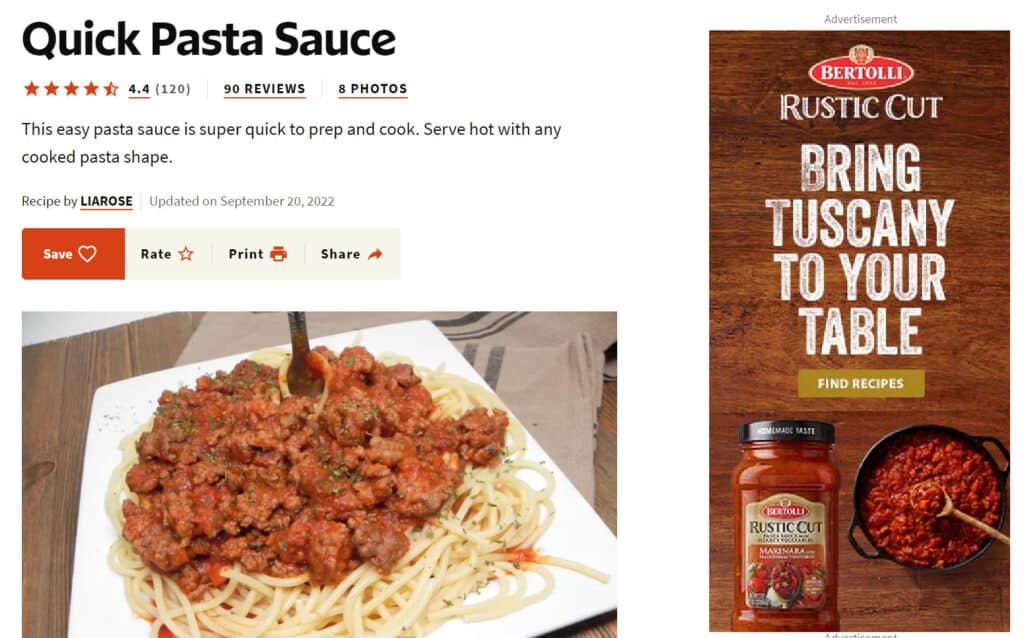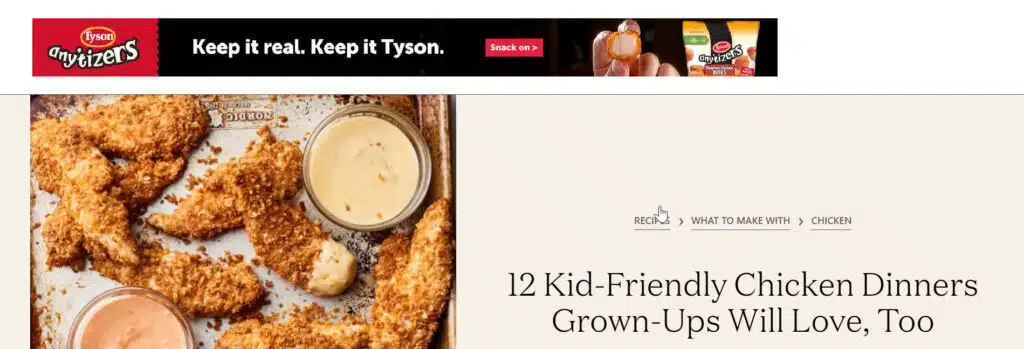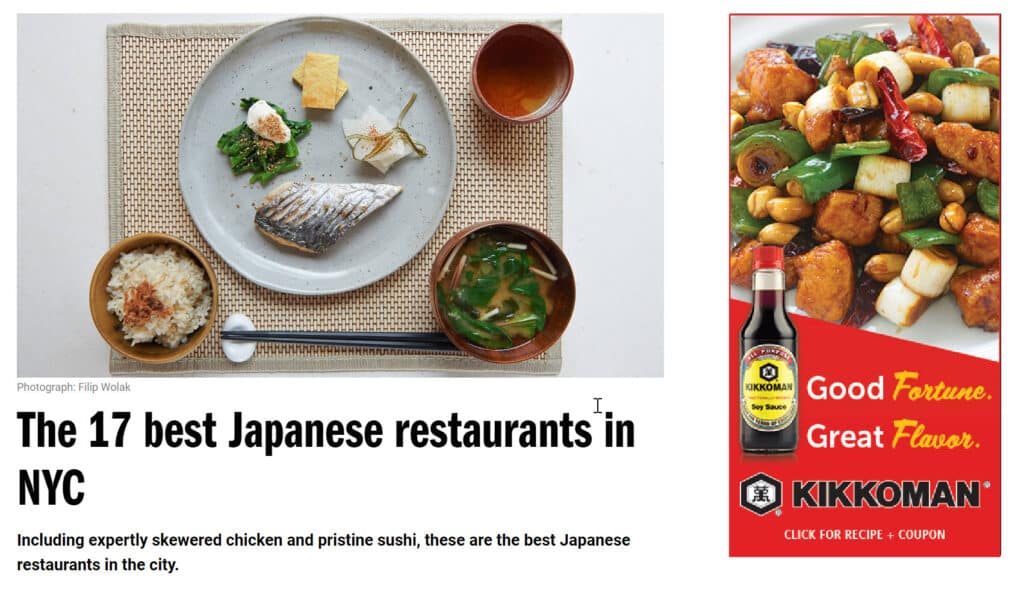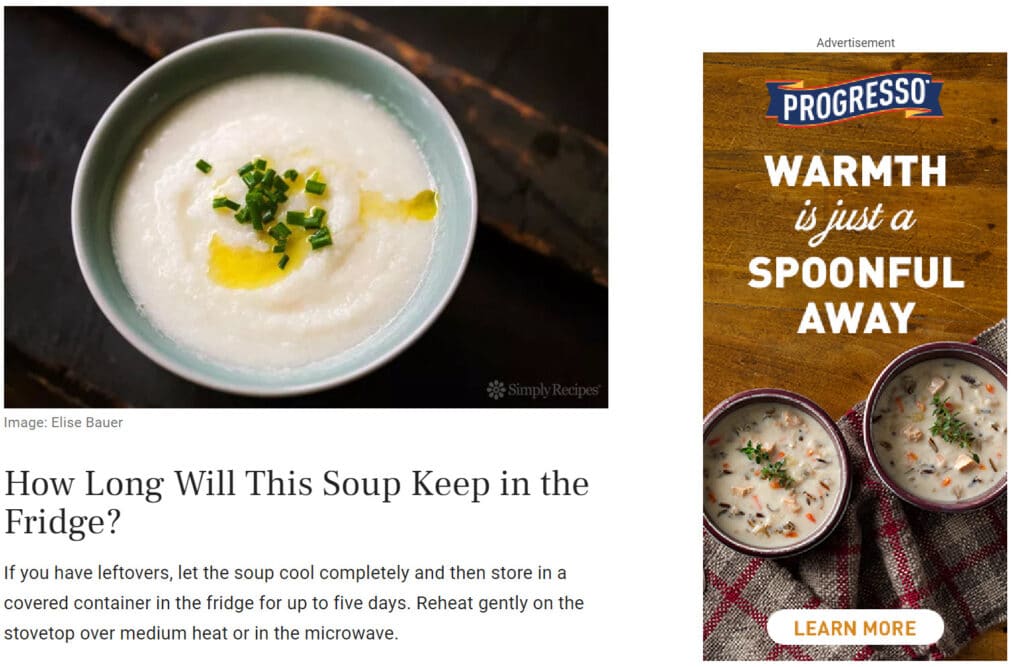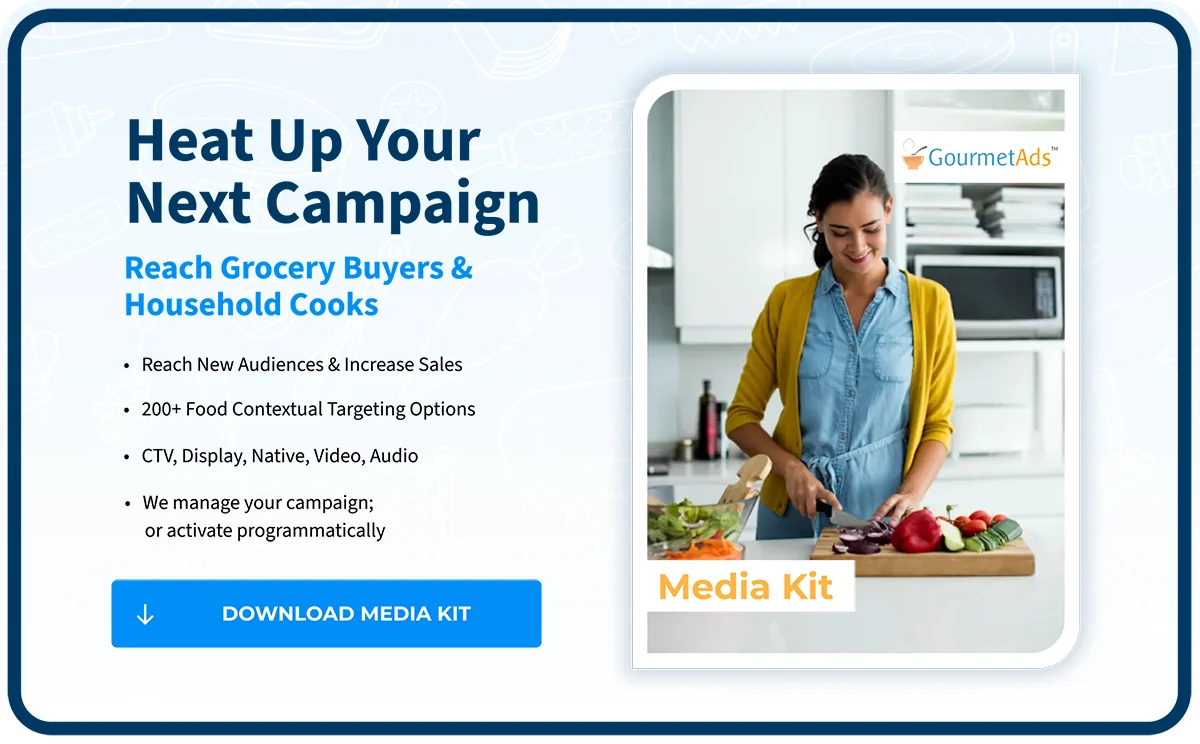Contextual Targeting
Contextual Targeting is the process of showing users highly relevant advertising based on the contextual content of the website or page they are visiting. Think of seeing a BBQ product advertisement next to a webpage about a BBQ Recipe – it’s about bridging the relevance gap to serve relevant ads and make advertising more meaningful and effective in a Privacy compliant way.
Contextual Targeting (sometimes referred to as Contextual Advertising), is reshaping the online advertising landscape, allowing advertisers to interact with their target audiences in a much more relevant. As a result, the user is more likely to engage with the advertisement and perhaps visit the advertiser’s website.
Let’s delve deeper to how Gourmet Ads can help you use Contextual Targeting in your next advertising campaign.
What is Contextual Targeting in Advertising?
Contextual Targeting Definition : Contextual Targeting in Advertising is a tailored strategy in the digital advertising sphere that presents ads based on the specific content of the web pages being viewed by a user. This strategy employs a sophisticated blend of keywords, topics, and various contextual data embedded within a webpage to display ads that harmonize with the user’s immediate online activity.
By aligning the advertising with the user’s current interest, this technique enhances user experience and boosts the relevance and effectiveness of the advertisement, thereby increasing the probability of engagement and conversion.
What Contextual Technology does Gourmet Ads use?
In 2020, Gourmet Ads’ engineering team began building from the ground up our own Contextual Engine called “The URL Project”. Our proprietary cutting-edge tool sets us apart in the industry, as it allows us to craft incredibly distinctive custom segments tailored to the specific needs of each advertiser.
Our framework is built around individual URLs and their relevance to a defined ruleset. Our URL Database includes the majority of the OpenWeb that sells advertising and features billions of URLs. Updated Daily, our crawler is constantly scouring and collecting new URLs when they are published (roughly 50k+ per day) and storing them in our URL database.
Each URL is subjected to rigorous analysis, following which it is integrated into relevant categorizations and segments as deemed appropriate. This allows us to build contextual segments that are highly specific whilst being able scaling for advertisers.
Our innovative approach empowers our technology to discern between words and topics with various implications, aiding advertisers in delivering ads that resonate more profoundly with the content. This advanced method transcends basic keyword reliance, paving the way for more relevant, effective advertising experiences.
The combination of our advanced crawling technology at the URL level and expertise in the creation of contextual segments ensures that our advertisers benefit from contextual advertising strategies that are truly one-of-a-kind, enhancing ad relevance, audience engagement, and overall campaign effectiveness.
Contextual Targeting Segments Taxonomy
There are numerous strategies we employ to build contextual segments, including content-based, semantic, keyword-based, and location-based techniques.
There is category targeting, in which ads are targeted to a web page that fall into pre-assigned categories and keyword targeting, in which ads are targeted to pages that match specific keywords.
We catgorize contextual segments into top level categories these being ;
Category |
Outline |
|---|---|
| Tap into our effective Alcohol Targeting at Gourmet Ads to serve ads that resonate with consumers in the liquor market. We fine-tune your campaign, reaching alcohol enthusiasts who are primed for your brand’s message. | |
| Leverage the power of Gourmet Ads’ Beverage Targeting to pinpoint individuals seeking their next favorite drink. We help connect your beverage brands with thirsty customers, ensuring a refreshing impact. | |
| Gourmet Ads’ Cuisine Targeting strategy dives deep into the food cultures that resonate with your brand. By reaching out to those immersed in specific cuisines, we help your brand become an integral part of their culinary experience. | |
| Diet Targeting at Gourmet Ads enables your brand to reach consumers making specific dietary choices. We align your campaigns with their dietary needs and preferences, connecting with them on a personal, health-focused level. | |
| Utilize Gourmet Ads’ Ingredient Targeting to reach home cooks searching for specific ingredients. We engage your audience when they’re looking to try new recipes or cooking techniques, turning ingredient searches into brand opportunities. | |
| With Gourmet Ads’ Kitchen Appliances Targeting, we ensure your brand reaches households in need of new culinary tools. We connect your products with consumers who are investing in their kitchens, driving purchases and brand loyalty. | |
| Non-Endemic Targeting at Gourmet Ads allows you to reach audiences outside your traditional demographic. By identifying opportunities in unlikely markets, we help your brand diversify its reach and discover untapped potential. | |
| Engage passionate cooks and food enthusiasts with Gourmet Ads’ Recipe Targeting. We position your brand amidst the culinary inspiration, becoming a key ingredient in their next favorite dish. |
Custom Contextual Targeting Segments
At Gourmet Ads, we understand that each brand is unique, with its distinct audience and specific advertising objectives. This core understanding underpins our custom contextual targeting offering. By curating unique ad environments based on relevant topics, keywords, and interests, we help Food, Supermarket and CPG brands deliver impactful ads that resonate with their audience’s immediate content consumption.
Making Customization the New Standard
Our Custom Contextual Targeting Segments leverage a brand’s nuances to the fullest. Whether it’s brand names, product specifics, consumer interests, demographics, or trending topics, our tailored approach ensures your ads are seen and resonate deeply with the target audience, driving engagement and campaign effectiveness.
Create your own contextual advertising segment by giving the Gourmet Ads team the relevant keywords and themes that describe the pages where you want your ad to appear, you may create your own contextual targeting ad group.
Contact Us with your Custom Contextual Targeting Requirements
Benefits of Contextual Targeting
Reach Specific Content
Advertisers can reach very specific content and thus, precise audiences.
Less Expensive
Compared to other targeting methods, Contextual Advertising is less expensive, becuase there is no 3rd Party data costs, making it a cost-efficient approach
Highly Scalable
Scale up or down depending on the campaign requirements, making it a highly flexible and adaptable strategy. Whether you’re aiming to reach a niche audience or a broad demographic, this strategy can be adjusted to meet varying campaign sizes and goals.
Higher Engagement Rates
Advertising that resonate with the content of a page have a higher chance of engaging users, leading to improved click-through rates.
Privacy Compliant
Contextual doesn’t rely on any personal user data, making it a privacy-friendly advertising approach compliant with GDPR and other data privacy regulations.
Brand Safety
Contextual Targeting ensures that ads are displayed alongside appropriate content, safeguarding brand reputation.
No Data Costs
With Contextual ads, advertisers are not required to invest in purchasing or analyzing large sets of consumer data. The strategy instead leverages the context of the webpage, eliminating additional data acquisition costs and delivering an efficient and cost-effective solution.
Contextual Targeting across all Media Types
At Gourmet Ads, we believe in maximizing the potential of advertising by integrating Contextual Ads across all major media types. This includes the power of Display Ads (think Banner Ad) that capture attention with dynamic visuals, the immersive engagement offered by Video Ads, and the seamless integration of Native Ads.
Display Ads
Our Display Ads take into account the page content (ie web pages) and display relevant ads, thereby elevating user experience and engagement.
Native Ads
As for Native Ads, we ensure they resonate with the surrounding content not just in theme, but in presentation, blending in seamlessly for a more organic user interaction.
Video Ads
With Video Ads, we align your promotional video content with pertinent webpage themes to create an engaging and harmonized viewing experience.
Contextual Targeting Examples
The realm of contextual advertising is vast and versatile, teeming with diverse examples that showcase its effectiveness. Let’s explore a few compelling instances, specifically focusing on the gastronomic world, where contextual advertisements seamlessly marries food product types with the most relevant web pages.
1. Pasta Sauce
Run your Pasta Sauce display ads across a range of pasta content such as Pasta Recipes, Pasta Dough Recipes, Pasta Sauces, Italian Restaurant Reviews and Italian Travel Reviews.
2. Frozen Chicken Products
Deploy your branded chicken product ads across popular chicken recipes like Chicken Kiev or Chicken Tenders as well as guides on cooking techniques for the perfect roast chicken dinner.
3. Soy Sauce
Strategically place your soy sauce advertisements across content related to popular Japanese dishes like sushi, teriyaki, and ramen recipes, as well as reviews of authentic Japanese restaurants.
4. Soup Mix
Promote your Soup Mix ads alongside content encompassing comforting soup recipes, meal prep tips involving soup mixes, and reviews of popular ready-made soup products.
Pricing of Contextual Targeting Segments
At Gourmet Ads, we strongly believe in delivering maximum value to our advertising clients. Keeping this in mind, we offer our Contextual Targeting Segments when activated via Managed Services or via Programmatic Advertising Deals at no charge.
Our primary goal is to ensure your online ads reach the right audience at the right time, enhancing engagement and conversion rates. We understand the importance of cost-effective advertising strategies, and our policy of not charging for usage is a testament to our commitment to providing superior services without burdening our clients with extra costs. We value your trust in us, and we work diligently to maximize your return on investment.
Activation via Managed Services or Programmatic Advertising Deals
Gourmet Ads takes pride in offering contextual advertising solutions across both managed services and programmatic advertising deals.
Managed Services
Our Managed Services take the complexity out of your contextual advertising strategy, handling everything from custom segment creation to ongoing optimization in the ad server.
Programmatic Advertising
On the other hand, our Programmatic Advertising deals streamline the ad-buying process, enabling you to purchase ads in real time based on the contextual targeting parameters we’ve helped you establish. This unique blend ensures precision targeting while promoting efficient ad spend. All we really need to think about is your location targeting.
Contextual Targeting vs Audience Targeting
Contextual Targeting and Audience Targeting are two significant strategies in the targeted advertising landscape, each with its unique strengths. Contextual Advertising focuses on the alignment of ads with the relevant content of the web page a user is currently viewing. It’s about the ‘context’ and ensuring that ads harmonize with the immediate environment, enhancing their relevance and impact. It doesn’t rely on user data, making it a privacy-friendly approach.
On the other hand, Audience Targeting hinges on the user’s past behaviors, interests, and demographics. It’s about ‘who’ is viewing the ad, with the aim to reach specific audience segments based on collected data. While it can be highly personalized, it often relies on the use of cookies, which can raise privacy concerns.
Both strategies have their merits, and the choice between them often depends on specific campaign goals, audience, and the evolving regulatory landscape around data privacy. It’s not uncommon for these strategies to be used in tandem, creating a balanced, effective, and holistic approach to online advertising.
Contextual and Behavioral Targeting
Contextual Targeting and Behavioral Targeting represent two distinct approaches in advertising, each designed to optimize user engagement and conversions. Contextual Targeting is about the ‘where’ and ‘when’, placing ads based on the content of the webpage a user is viewing at a particular moment. It ensures the ad’s relevance to the content, providing a seamless and enhanced user experience. Notably, it does not rely on gathering personal data, making it a more privacy-conscious approach.
In contrast, Behavioral Targeting (often referred to as Behavioral Advertising) focuses on the ‘who’, delivering ads based on a user’s past online behavior, such as search history, site visits, and clicked ads (first party data). Behavioral Targeting aims to personalize the ad experience by understanding and predicting user behavior, thus increasing the chances of engagement. While highly personalized, Behavioral Advertising relies heavily on tracking user data, which can be seen as intrusive and raise privacy concerns.
The choice between Contextual Marketing and Behavioral Advertising often depends on campaign objectives, target audience, and how advertisers balance personalization with privacy concerns. It’s common to see both methods employed together to achieve a well-rounded, effective advertising strategy that benefits both the advertiser and the end user.
Keyword Targeting – Positive and Negative Contexts
Keyword Targeting, a crucial aspect of Contextual Targeting, ensures your contextual ads are displayed alongside the most relevant content. Keyword targeting can be used in both positive and negative contexts. When we talk about positive context, it implies choosing specific keywords that align with your food product or service. When these keywords appear on a webpage, your ads are shown. For instance, an advertiser marketing a new pasta sauce might target keywords like ‘pasta recipes’, ‘Italian cuisine’, or ‘homemade sauce’. This ensures their contextual ad is displayed on webpages where these enticing topics are explored.
Conversely, negative keyword targeting is used to prevent your ads from appearing in irrelevant or potentially harmful contexts. It involves specifying keywords that, when present in a webpage’s content, will exclude your ads from being displayed. For example, a gourmet dessert brand might want to avoid keywords like ‘dieting’ or ‘sugar-free’.
This strategic use of both positive and negative contexts using keywords helps create an ideal balance, enhancing your ad’s relevance, effectiveness, and safeguarding your brand image.
The Future of Contextual Targeting
The future of Contextual Advertising across the advertising world is brimming with promise and potential, thanks to the rapid advancement in technology and an increased emphasis on data privacy.
For starters, the impending demise of third-party cookies due to growing privacy concerns and regulatory changes is prompting ad buyers to explore alternative strategies like Contextual. This method, which respects user privacy and doesn’t rely on personal data, is set to gain even more traction in the coming years, emerging as a powerful, privacy-friendly advertising tool.
Furthermore, advancements in machine learning and artificial intelligence technologies are set to revolutionize Contextual Advertising. Algorithms are becoming increasingly sophisticated, capable of analyzing not just the keywords, but also the overall sentiment, themes, and subtler nuances of a webpage’s content. This would make Contextual Advertising more precise and effective, allowing for even better alignment between ads and content.
Another trend to watch out for is the integration of Contextual Advertising across different media types, like connected TV (CTV) and digital out-of-home (DOOH). As advertisers seek to provide a seamless, omnichannel experience, the use of Contextual across these platforms is likely to grow.
Lastly, we can expect more customization and flexibility in the creation of Contextual Segments. Gourmet Ads, for instance, is already pioneering this aspect, with the ability to tailor highly specific Contextual Segments based on advertisers’ unique needs.
Since 2008, Gourmet Ads has been the global leader in food-focused advertising, specializing in Contextual Targeting. Discover a wide range of Food Targeting Categories for your next advertising campaign or programmatic deals, including Alcohol, Beverage, Cuisine, Diet, Ingredient, Kitchen Appliances, Non-Endemic, Publisher, and Recipe Targeting. We ensure your brand resonates with an engaged, culinary-inclined audience, transforming advertising campaigns into deliciously successful endeavors. Experience Gourmet Ads—where your message meets the appetite of your desired market.
Let the Gourmet Ads team walk you through all the options available to ensure that your Food, Supermarket, Beverage or Kitchen advertising campaign has the best possible combination of Premium Guaranteed Inventory, Scale, First Party Data, Contextual Targeting and Programmatic Advertising elements.








